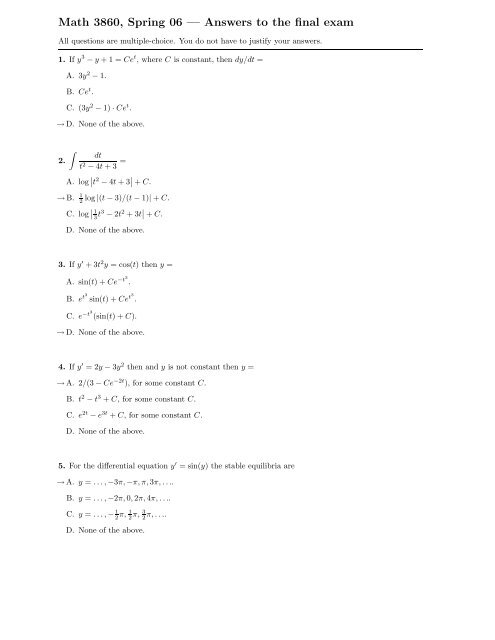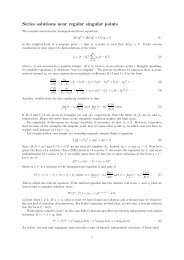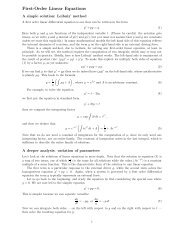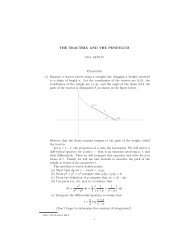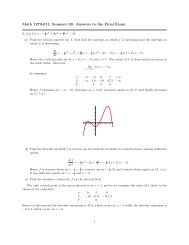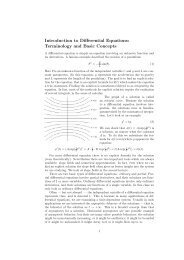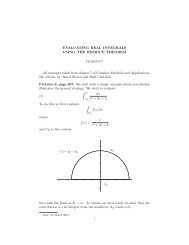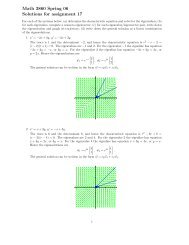Math 3860, Spring 06 â Answers to the final exam - The Live Toad
Math 3860, Spring 06 â Answers to the final exam - The Live Toad
Math 3860, Spring 06 â Answers to the final exam - The Live Toad
- No tags were found...
Create successful ePaper yourself
Turn your PDF publications into a flip-book with our unique Google optimized e-Paper software.
<strong>Math</strong> <strong>3860</strong>, <strong>Spring</strong> <strong>06</strong> — <strong>Answers</strong> <strong>to</strong> <strong>the</strong> <strong>final</strong> <strong>exam</strong>All questions are multiple-choice. You do not have <strong>to</strong> justify your answers.1. If y 3 − y + 1 = Ce t , where C is constant, <strong>the</strong>n dy/dt =A. 3y 2 − 1.B. Ce t .C. (3y 2 − 1) · Ce t .→ D. None of <strong>the</strong> above.∫2.dtt 2 − 4t + 3 =A. log ∣ ∣ t 2 − 4t + 3 ∣ ∣ + C.1→ B.2log |(t − 3)/(t − 1)| + C.C. log ∣ ∣13 t3 − 2t 2 + 3t ∣ ∣ + C.D. None of <strong>the</strong> above.3. If y ′ + 3t 2 y = cos(t) <strong>the</strong>n y =A. sin(t) + Ce −t3 .B. e t3 sin(t) + Ce t3 .C. e −t3 (sin(t) + C).→ D. None of <strong>the</strong> above.4. If y ′ = 2y − 3y 2 <strong>the</strong>n and y is not constant <strong>the</strong>n y =→ A. 2/(3 − Ce −2t ), for some constant C.B. t 2 − t 3 + C, for some constant C.C. e 2t − e 3t + C, for some constant C.D. None of <strong>the</strong> above.5. For <strong>the</strong> differential equation y ′ = sin(y) <strong>the</strong> stable equilibria are→ A. y = . . . , −3π, −π, π, 3π, . . ..B. y = . . . , −2π, 0, 2π, 4π, . . ..C. y = . . . , − 1 2 π, 1 2 π, 3 2π, . . ..D. None of <strong>the</strong> above.
6. <strong>The</strong> domain of validity for <strong>the</strong> solution of <strong>the</strong> initial value problem y ′ = 2y − 3y 2 , y(0) = 1 isA. (0, 2/3).→ B. (− ln √ 3, +∞).C. (−∞, +∞).D. None of <strong>the</strong> above.7. <strong>The</strong> domain of validity for <strong>the</strong> solution of <strong>the</strong> initial value problem (t 2 − 4)y ′ + (t − 1)y = √ t + 1,y(0) = −3 isA. (−2, 1).→ B. (−1, 2).C. (−1, 1).D. None of <strong>the</strong> above.8. Any two solutions <strong>to</strong> a linear differential equationA. differ by a constant of integration.→ B. differ by a solution of <strong>the</strong> homogeneous equation.C. differ by a solution of <strong>the</strong> nonhomogeneous equation.D. None of <strong>the</strong> above.9. <strong>The</strong> integral equation y(t) = −3 +A. y ′ = ty − 2, y(0) = −3.B. y ′ = ty + 3, y(−3) = 2.→ C. y ′ = ty, y(2) = −3.D. None of <strong>the</strong> above.∫ t2s y(s)ds is equivalent <strong>to</strong> <strong>the</strong> initial value problem10. <strong>The</strong> local truncation error in <strong>the</strong> Euler-Heun methodA. decreases linearly in <strong>the</strong> step size.B. decreases quadratically in <strong>the</strong> step size.→ C. decreases cubically in <strong>the</strong> step size.D. None of <strong>the</strong> above.
11. <strong>The</strong> global error in <strong>the</strong> Euler-Heun methodA. decreases linearly in <strong>the</strong> step size.→ B. decreases quadratically in <strong>the</strong> step size.C. decreases cubically in <strong>the</strong> step size.D. None of <strong>the</strong> above.12. <strong>The</strong> power series representation of f(t) = (t − 1)e t at t 0 = 0 isA. 1 + (t − 1) + 1 2 (t − 1)2 + 1 6 (t − 1)3 + 124 (t − 1)4 + · · · .→ B. −1 + 1 2 t2 + 1 3 t3 + 1 8 t4 + · · · .C. 1 − t + 1 2 t2 − 1 6 t3 + 124 t4 + · · · .D. None of <strong>the</strong> above.13. Any power series solution at t 0 = 0 for <strong>the</strong> differential equation (t 2 − 4)y ′′ + ty ′ + 3y = 0 has radiusof convergenceA. less than or equal <strong>to</strong> 2.B. exactly equal <strong>to</strong> 2.→ C. greater than or equal <strong>to</strong> 2.D. None of <strong>the</strong> above.14. If we apply <strong>the</strong> Euler-Heun method <strong>to</strong> <strong>the</strong> initial value problem y ′ = 2ty, y(0) = 1 using a step sizeof 0.1 <strong>the</strong>n <strong>the</strong> relative global error after one step is approximatelyA. 1%.B. 0.1%.→ C. 0.005%.D. None of <strong>the</strong> above.15. If <strong>the</strong> phase portrait of <strong>the</strong> constant-coefficent system ⃗w ′ = P ⃗w exhibits a saddle point <strong>the</strong>nA. tr(P) < 0.→ B. det(P) < 0.C. tr(P) 2 < 4 det(P).D. None of <strong>the</strong> above.
16. If <strong>the</strong> phase portrait of <strong>the</strong> constant-coefficent system ⃗w ′ = P ⃗w exhibits a stable spiral <strong>the</strong>n→ A. tr(P) < 0 and tr(P) 2 < 4 det(P).B. tr(P) < 0 and tr(P) 2 > 4 det(P).C. tr(P) < 0 and det(P) < 0.D. None of <strong>the</strong> above.17. If y ′′ + 4y ′ + 5y = 0, y(0) = 2, y ′ (0) = −3, <strong>the</strong> y =A. e −2t (2 cos(t) + i sin(t)).B. e −2t (2 cos(t) + sin(it)).→ C. e −2t (2 cos(t) + sin(t)).D. None of <strong>the</strong> above.18. If y ′′ − 3y ′ + 2y = 2t 2 − 1, y(0) = 1, y ′ (0) = 1, <strong>the</strong>n y =→ A. t 2 + 3t + 3 − 2e t .B. t 2 + 3e 2t − 2e t .C. t 2 + 3e 2t + 2e −t .D. None of <strong>the</strong> above.19. If f(t) = t, when 0 ≤ t < 1, and f(t) = 0 o<strong>the</strong>rwise, <strong>the</strong>n L {f(t)} =A. s −2 · (1 − e −s ).B. 2s −2 · (1 − e −s ).C. s −1 · (1 − e −s ).→ D. None of <strong>the</strong> above.20. If Y (s) = s −1 /(1 + e −2s ) <strong>the</strong>n L −1 {Y (s)} =→ A. u 0 (t) − u 2 (t) + u 4 (t) − u 6 (t) + · · ·.B. u 0 (t) − 2u 1 (t) + 4u 2 (t) − 6u 4 (t) + · · · .C. u 0 (t) + u 2 (t)e −2t + u 4 (t)e −4t + u 6 (t)e −6t + · · · .D. None of <strong>the</strong> above.


